The Monarch Butterfly
The Monarch Butterfly
The Monarch Butterfly is a primarily American species of migratory Lepidoptera of the family Nymphalidae and the subfamily Danainae.
This large butterfly is famous for its large-scale migrations into America, where it moves in groups of millions of individuals over distances of up to 4,000 km, twice a year, from August to October to the south, especially in Mexico and in spring to the north.
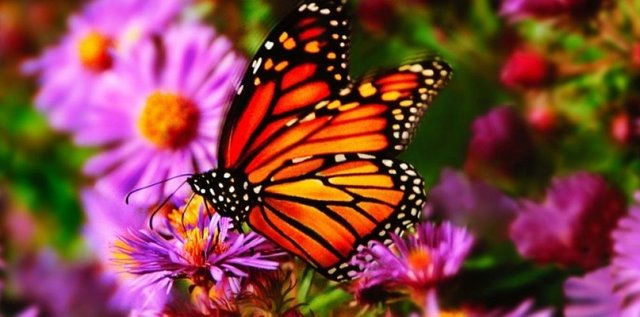
The imago of Monarch (refers to the final stage of an individual whose development takes place in several phases (usually egg, larva, imago) is a large butterfly, whose wingspan ranges from 8.6 to 12.4 cm The wings and body are slightly smaller in populations that do not migrate, and its wing patterns consist of an orange, veined, black-edged bottom, with the apex and wing margins adorned with white spots.
In the adult stage, the Monarch has a sexual dimorphism. Males are larger than females, but their wings are thinner. They have a more vivid orange hue. On the dorsal surface of their hind wings, males carry an androconia, a spot on the central vein. Females do not have this task but have a larger rib.
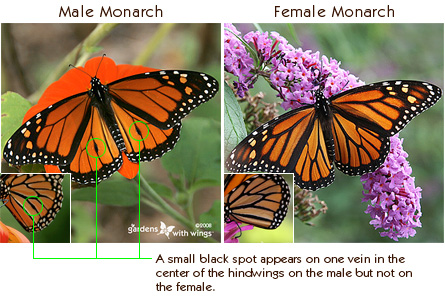
There is a rare form of monarchs that are white instead of orange. This phenotype, called nivosus, has been observed in Australia, New Zealand, Indonesia and the United States. It generally represents only 1% of individuals, with the exception of Oahu, an island in Hawaii, where the nivosus phenotype has already accounted for nearly 10% of individuals.
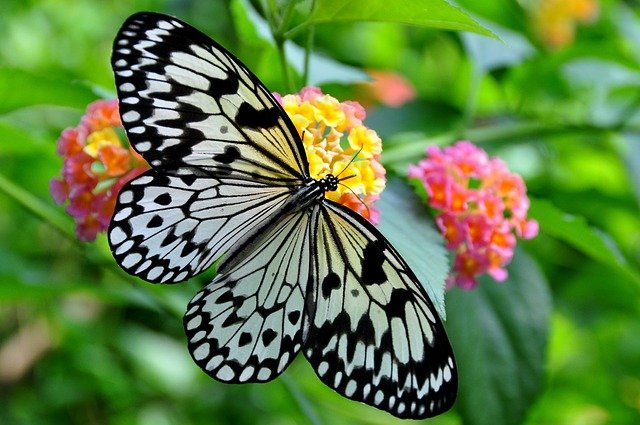
Caterpillar
The Monarch caterpillar passes through five stages, separated by moults, before forming a chrysalis. At each stage, the caterpillar is larger than the previous one. Leaving the egg, the young caterpillar is pale green and translucent. It does not have a motive or filament. It is 2 to 6 mm long and 0.5 to 1.5 mm wide. It is after moulting once that the caterpillar has the typical pattern of black, white and yellow stripes. A pair of black filaments appears at each end of the body.
After the second moult, the colored bands are more distinct and the filaments are longer. The legs are differentiated into a small pair near the head and two other larger pairs at the back of the chest. After the third moult, the caterpillar bears white spots on the false hind legs. In the last stage of the caterpillar, which comes after the fourth moult, the patterns are more complex, the white spots on the false legs are still present and the front legs are very close to the head. At this stage, the caterpillar is 2.5 to 4.5 cm long and 5 to 8 mm wide.
Biology
The bright colors of this species, both in the larval stage and in the adult stage, are supposed to be a warning signal for possible predators, a phenomenon called aposematism. Eggs are laid on milkweed plants, which contain toxic alkaloids and cardenolides for many animals but not for Monarchs. Following the hatching of its egg, the caterpillar consumes milkweed leaves, sequesters and stores cardenolides, making it indigestible for its vertebrate predators, mainly birds.
It flies from April to October in several generations and has a diapause (genetically determined phase in the development of an organism where it decreases the intensity of its metabolic activities.It is considered that the animal, the plant or the cell (bacterium mushroom ...) is slowed down according to complex physiological and biological processes in anticipated response to environmental variations) from late autumn to spring.
This species occurs throughout South America and all of North America, the Canary Islands, Australia, New Zealand, New Guinea, New Caledonia and the Mascarenes.
In Europe, he is an occasional migrator in the Azores and Portugal and an exceptional migrator in France, Great Britain and Ireland.
Migration
One of the most curious aspects of monarch migration is that their journey from south to north is multi-generational, while the journey from north to south is one. Monarchs born in autumn enter a diapause phase, allowing them to survive the entire winter. This will allow them to migrate from the Great Lakes region and southern California to the state of Michoacán in Mexico, where they will live idle in sacred fir forests. The monarchs are present in such large numbers that one can not even distinguish the smallest piece of bark where they arise. Monarchs gather in swarms at night and take flight during the day, if the temperature is high enough.
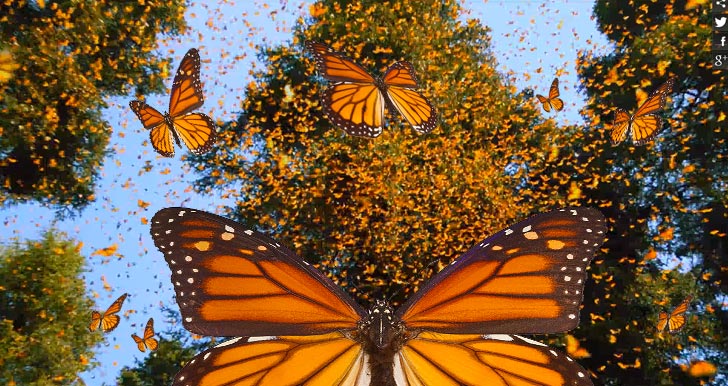
This whole cycle is necessary for the monarchs to gain strength for the breeding that will take place in March, just before taking off for the North. The trip to the North will take several generations. The normal life span of a monarch is about two months in the summer, and more than seven months for the winter form.
The reasons for this migration and how butterflies find the same place as their predecessors after several generations remain partially enigmatic. We know that the Monarch uses a kind of solar compass located in his middle brain, and circadian clocks located in their antennas. Researchers have shown that a slight drop in temperature is the signal to begin migration north.
Protection
Given the significant decline in monarch butterflies observed in Mexico and California since the 1990s, the status of this species is of concern to many environmental groups and governments. In Canada, Monarch is an endangered species. In the United States, the species is being evaluated to determine if it will be listed under the Endangered Species Act.
Industrial agriculture and the general pollution of the environment by insecticides, but especially the use of weed killers, which eliminates or strongly reduces the milkweed of the farming and / or cultivated areas are some of the causes of its decline. The wintering area of monarchs was divided by 3 between the years 1993-2003 and 2004-2013. Forest deforestation and soil erosion also threaten the forests of Michoacán, Mexico, where Monarchs are used to wintering.
Among the other hypotheses put forward is the change in the male to female ratio. Indeed, the proportion of females has declined for 30 years. According to the authors, it is a parasite, Ophryocystis elektroscirrha, whose negative impact would affect females more than males. A citizen science project, MonarchHealth, has been set up to better understand the impact of this parasite on the Monarch.
As an emblematic species, the Monarch enjoys specific programs and a strategic protection plan, in the north (protection of habitats containing milkweeds, awareness of the population invited to follow the migration), and in the south (including promotion of local ecotourism near breeding areas). The Butterfly Garden in Saint-Pierre (Martinique) helps protect several species of butterflies including the Monarch butterfly.
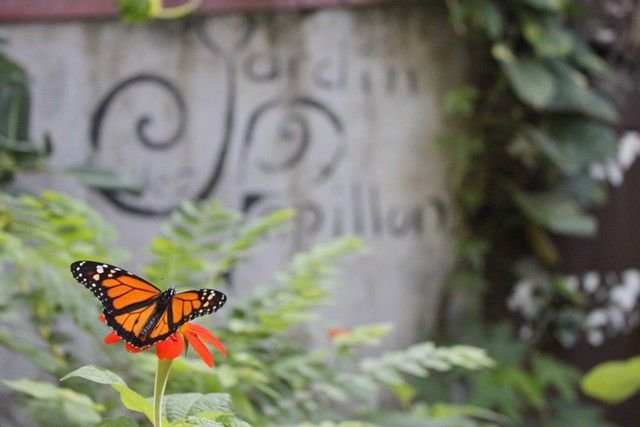
Butterflies are the symbol of good ecosystem and healthy surroundings. Good source of knowledge. Most of them having a source of food chain to other pillage.
thanks for sharing .
Beautiful :) Thanks for sharing. Lovely & Peaceful day!! I am followed u:)
OMG.Beautiful. The colors look stunning.
You got a 1.46% upvote from @allaz courtesy of @upali!
Earlier this butterfly met much more often than now.
Thanks for sharing a beautiful inforamtion about butterfly
You always come with a new and good contents it good for me to learn new thing keep it up I wish you all the best
God bless you
I am followed U! Lovely day !:)
Today you spoil us with a variety of information. It was interesting to learn about taklm form of butterflies. In fact, we often see (in summer) butterflies, but rarely pay attention to them. But what do people really know about them? the banal information. But you made an excellent post that briefly outlined the characteristics of this species of butterflies. I like it.
Thank you
Lovely things butterflies, I tried taking some photos once in a butterfly house but unfortunately my lenses just kept steaming up, if you like nature you might just like my latest post about the blue tit. Cheers mike
Looking naturally image,
Nice post, I resteem it
Thank you
Beautiful photography really amazing photos nice post thanks for sharing..I will done upvote .....
Its amazing to learn that these Butterflies migrate from North to South.
At the same time, it's the shame that they have now in the endangered species list.
I used to see a lot of them during my primary school days, now the numbers have drastically reduced.
Guess we humans are the only one to be blamed.
The adult butterfly’s primary instinctive behavior in life is to search for a mate of the same species and produce viable offspring to carry on their genes. This includes making sure the eggs are laid on the correct host plant. Some butterflies lay their eggs in groups, while others lay them singly because the first instar caterpillars can be cannibalistic and will eat the other eggs. have a nice day bro